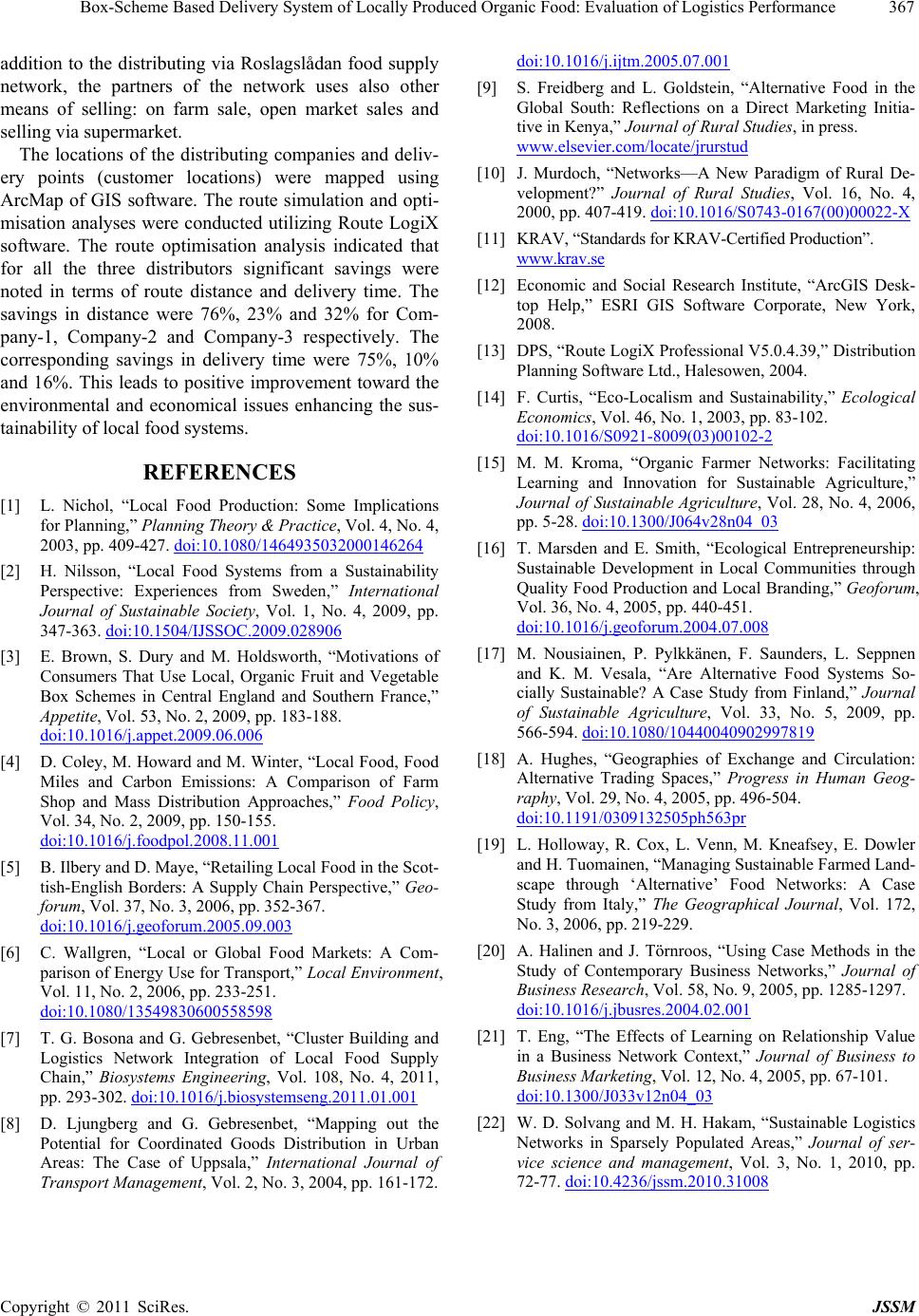
Box-Scheme Based Delivery System of Locally Produced Organic Food: Evaluation of Logistics Performance367
addition to the distributing via Roslagslådan food supply
network, the partners of the network uses also other
means of selling: on farm sale, open market sales and
selling via supermarket.
The locations of the distributing companies and deliv-
ery points (customer locations) were mapped using
ArcMap of GIS software. The route simulation and opti-
misation analyses were conducted utilizing Route LogiX
software. The route optimisation analysis indicated that
for all the three distributors significant savings were
noted in terms of route distance and delivery time. The
savings in distance were 76%, 23% and 32% for Com-
pany-1, Company-2 and Company-3 respectively. The
corresponding savings in delivery time were 75%, 10%
and 16%. This leads to positive improvement toward the
environmental and economical issues enhancing the sus-
tainability of local food systems.
REFERENCES
[1] L. Nichol, “Local Food Production: Some Implications
for Planning,” Planning Theory & Practice, Vol. 4, No. 4,
2003, pp. 409-427. doi:10.1080/1464935032000146264
[2] H. Nilsson, “Local Food Systems from a Sustainability
Perspective: Experiences from Sweden,” International
Journal of Sustainable Society, Vol. 1, No. 4, 2009, pp.
347-363. doi:10.1504/IJSSOC.2009.028906
[3] E. Brown, S. Dury and M. Holdsworth, “Motivations of
Consumers That Use Local, Organic Fruit and Vegetable
Box Schemes in Central England and Southern France,”
Appetite, Vol. 53, No. 2, 2009, pp. 183-188.
doi:10.1016/j.appet.2009.06.006
[4] D. Coley, M. Howard and M. Winter, “Local Food, Food
Miles and Carbon Emissions: A Comparison of Farm
Shop and Mass Distribution Approaches,” Food Policy,
Vol. 34, No. 2, 2009, pp. 150-155.
doi:10.1016/j.foodpol.2008.11.001
[5] B. Ilbery and D. Maye, “Retailing Local Food in the Scot-
tish-English Borders: A Supply Chain Perspective,” Geo-
forum, Vol. 37, No. 3, 2006, pp. 352-367.
doi:10.1016/j.geoforum.2005.09.003
[6] C. Wallgren, “Local or Global Food Markets: A Com-
parison of Energy Use for Transport,” Local Environment,
Vol. 11, No. 2, 2006, pp. 233-251.
doi:10.1080/13549830600558598
[7] T. G. Bosona and G. Gebresenbet, “Cluster Building and
Logistics Network Integration of Local Food Supply
Chain,” Biosystems Engineering, Vol. 108, No. 4, 2011,
pp. 293-302. doi:10.1016/j.biosystemseng.2011.01.001
[8] D. Ljungberg and G. Gebresenbet, “Mapping out the
Potential for Coordinated Goods Distribution in Urban
Areas: The Case of Uppsala,” International Journal of
Transport Management, Vol. 2, No. 3, 2004, pp. 161-172.
doi:10.1016/j.ijtm.2005.07.001
[9] S. Freidberg and L. Goldstein, “Alternative Food in the
Global South: Reflections on a Direct Marketing Initia-
tive in Kenya,” Journal of Rural Studies, in press.
www.elsevier.com/locate/jrurstud
[10] J. Murdoch, “Networks—A New Paradigm of Rural De-
velopment?” Journal of Rural Studies, Vol. 16, No. 4,
2000, pp. 407-419. doi:10.1016/S0743-0167(00)00022-X
[11] KRAV, “Standards for KRAV-Certified Production”.
www.krav. se
[12] Economic and Social Research Institute, “ArcGIS Desk-
top Help,” ESRI GIS Software Corporate, New York,
2008.
[13] DPS, “Route LogiX Professional V5.0.4.39,” Distribution
Planning Software Ltd., Halesowen, 2004.
[14] F. Curtis, “Eco-Localism and Sustainability,” Ecological
Economics, Vol. 46, No. 1, 2003, pp. 83-102.
doi:10.1016/S0921-8009(03)00102-2
[15] M. M. Kroma, “Organic Farmer Networks: Facilitating
Learning and Innovation for Sustainable Agriculture,”
Journal of Sustainable Agriculture, Vol. 28, No. 4, 2006,
pp. 5-28. doi:10.1300/J064v28n04_03
[16] T. Marsden and E. Smith, “Ecological Entrepreneurship:
Sustainable Development in Local Communities through
Quality Food Production and Local Branding,” Geoforum,
Vol. 36, No. 4, 2005, pp. 440-451.
doi:10.1016/j.geoforum.2004.07.008
[17] M. Nousiainen, P. Pylkkänen, F. Saunders, L. Seppnen
and K. M. Vesala, “Are Alternative Food Systems So-
cially Sustainable? A Case Study from Finland,” Journal
of Sustainable Agriculture, Vol. 33, No. 5, 2009, pp.
566-594. doi:10.1080/10440040902997819
[18] A. Hughes, “Geographies of Exchange and Circulation:
Alternative Trading Spaces,” Progress in Human Geog-
raphy, Vol. 29, No. 4, 2005, pp. 496-504.
doi:10.1191/0309132505ph563pr
[19] L. Holloway, R. Cox, L. Venn, M. Kneafsey, E. Dowler
and H. Tuomainen, “Managing Sustainable Farmed Land-
scape through ‘Alternative’ Food Networks: A Case
Study from Italy,” The Geographical Journal, Vol. 172,
No. 3, 2006, pp. 219-229.
[20] A. Halinen and J. Törnroos, “Using Case Methods in the
Study of Contemporary Business Networks,” Journal of
Business Research, Vol. 58, No. 9, 2005, pp. 1285-1297.
doi:10.1016/j.jbusres.2004.02.001
[21] T. Eng, “The Effects of Learning on Relationship Value
in a Business Network Context,” Journal of Business to
Business Marketing, Vol. 12, No. 4, 2005, pp. 67-101.
doi:10.1300/J033v12n04_03
[22] W. D. Solvang and M. H. Hakam, “Sustainable Logistics
Networks in Sparsely Populated Areas,” Journal of ser-
vice science and management, Vol. 3, No. 1, 2010, pp.
72-77. doi:10.4236/jssm.2010.31008
Copyright © 2011 SciRes. JSSM